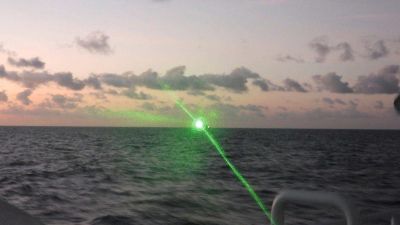China blinding Philippine ship crew with laser not enough to trigger US defence pact

Chinese coast guards shining a military-grade laser at a Philippine patrol vessel and briefly dazzling crew on board will not trigger a mutual defence treaty with the US.
The Philippines’ president Ferdinand Marcos Jr. told a news conference the move made in the disputed South China Sea was not enough for him to invoke the treaty.
He reminded China’s ambassador to Manila that escalating aggression and incursions into Philippine waters by Chinese coast guard, navy and maritime militia forces violate an agreement he struck with president Xi Jinping last month.
“Despite the fact that it was a military-grade laser that was pointed at our coast guard, I do not think that that is sufficient for it to trigger the Mutual Defence Treaty,” Marcos said in his first public remarks about the incident on February 6.
The incident involved two Chinese and Philippine coast guard vessels near the disputed Second Thomas Shoal, in the Spratly Islands.
It is thought the high-grade laser was shone to prevent the BRP Malapascua patrol vessel from approaching the Philippine military-occupied shoal.
Speaking to reporters in the northern resort city of Baguio, Marcos said he was concerned that activating the 1951 treaty would ratchet up regional tensions.
Mr Marcos also delivered a speech to cadets and former graduates of the Philippine Military Academy and vowed to defend the country’s territory amid a new territorial spat with China.
He was met with applause as he said: “This country will not lose one inch of its territory. We will continue to uphold our territorial integrity and sovereignty in accordance with our constitution and with international law.
“We will work with our neighbours to secure the safety and security of our peoples.”
Like his predecessor, Rodrigo Duterte, Marcos has taken steps to nurture friendly ties with Beijing.
He met Mr Xi in the Chinese capital early last month to boost relations and discuss the Asian neighbours’ long-seething territorial disputes in the strategic waterway that also involve Vietnam, Malaysia, Taiwan and Brunei.
China claims the South China Sea virtually in its entirety, putting it on a collision course with other Asian nations.
It is also likely to cause problems with Washington, which has deployed Navy ships and fighter jets to patrol the waters, promote freedom of mobility and challenge China’s territorial claims.
China claims its coast guard ship used a hand-held laser and another light-emitting gadget to harmlessly measure the distance and speed of BRP Malapascua, which it claimed intruded into Chinese waters and was warned to leave the area.
But US State Department spokesperson Ned Price said China’s “dangerous operational behaviour directly threatens regional peace and security, infringes upon freedom of navigation in the South China Sea as guaranteed under international law”.
He said Washington is standing by its treaty ally Manila following the latest sea feud, renewing a warning that an armed attack on Philippine armed forces, vessels or aircraft would invoke military action.
Want a quick and expert briefing on the biggest news stories? Listen to our latest podcasts to find out What You Need To know...